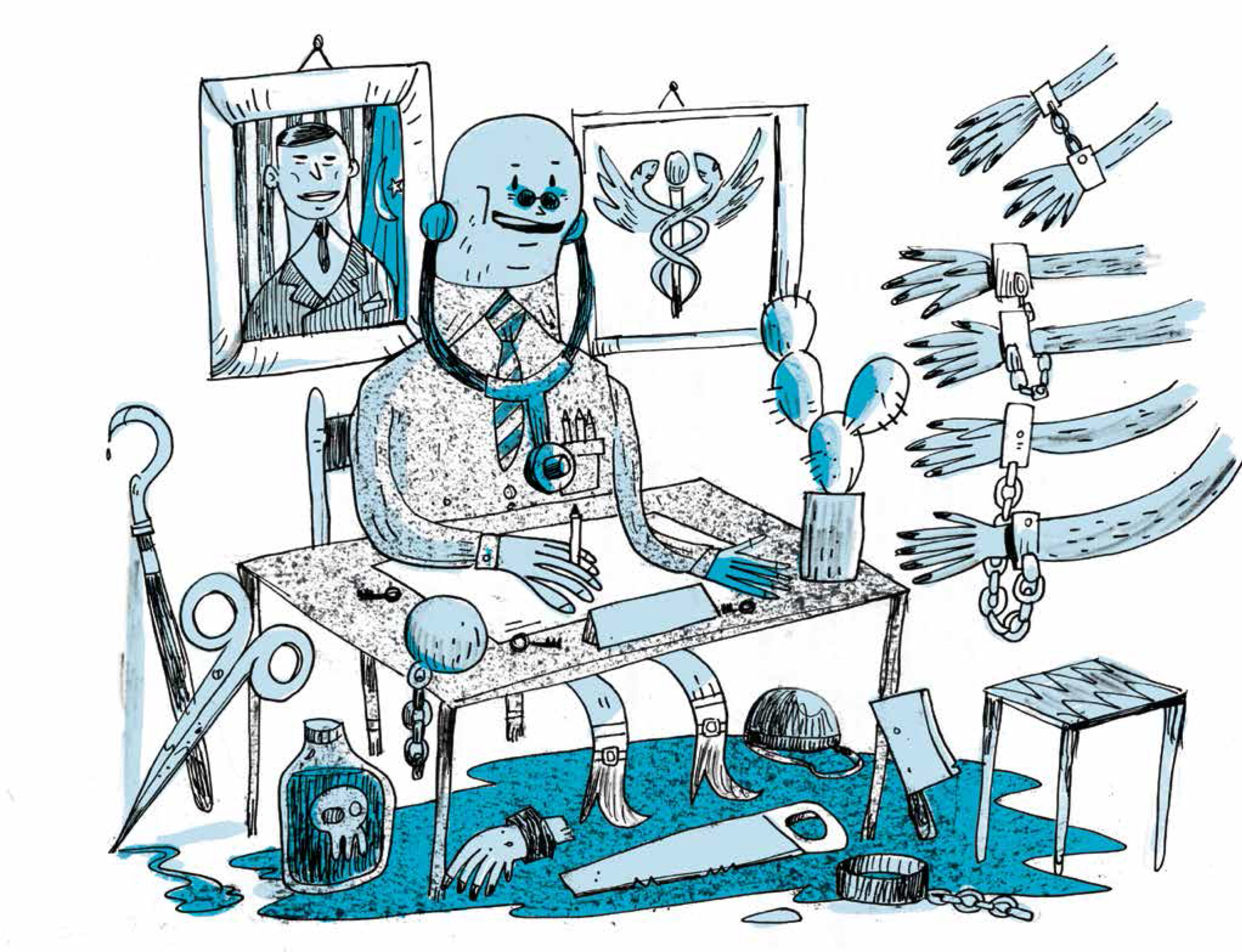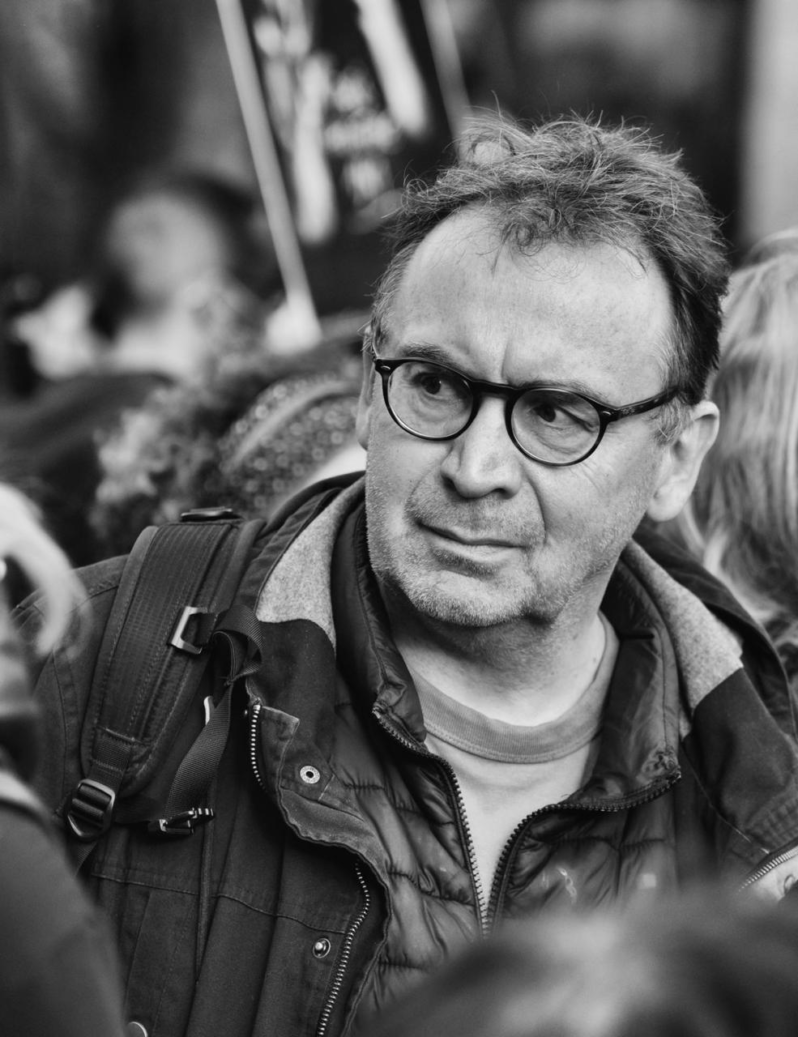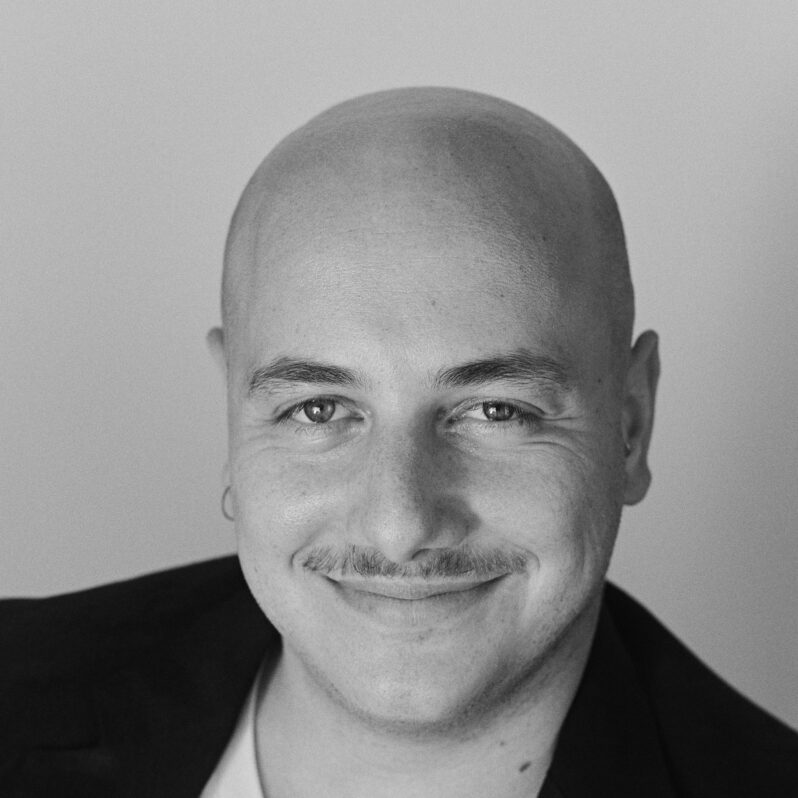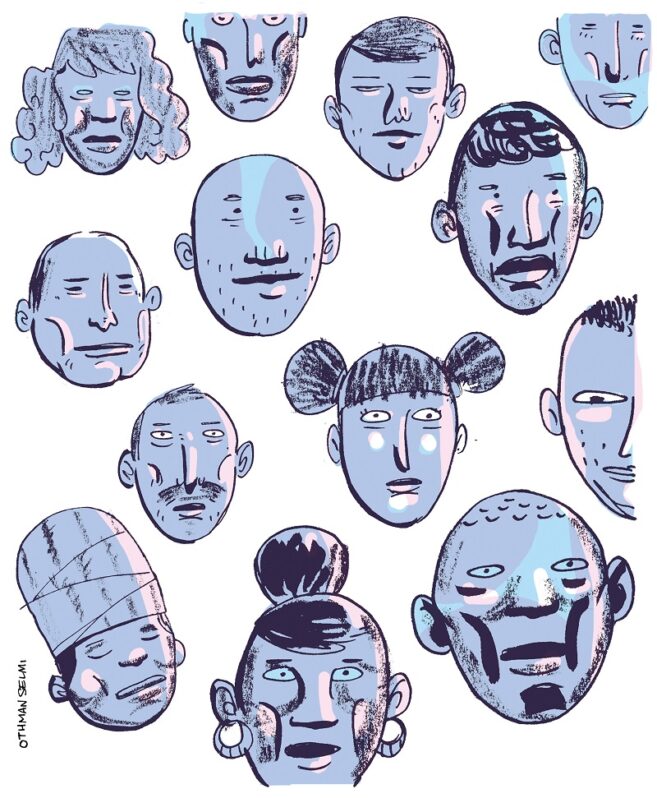Public Hearings for the Victims of Torture: The Presence of the Absent Torturer

Tunisia’s Truth and Dignity Commission dedicated its first public hearings to the victims of grave human rights violations. Those accused of involvement in these violations were absent from the hearings, but not because they denied the accusations. Commission member Oula Ben Nejma revealed that some of the torturers had confessed in the secret hearings,[1] which suggests that their absence in the first stages of the public hearings is merely part of the plan. The torturer is expected to attend during 2017[2] as a carefully planned escalation in the format of the hearings. While the Commission intentionally excluded the torturer figure from its most important activity in 2016, his absence was not absolute; when the victims spoke of their experience, they conjured up images of their torturer, whose features still haunt them.
In his first incarnation, the torturer was a security agent exercising his authority on the victim’s body, revealing his character in the process.[3] The torturer was also the physician whose white coat did not prevent him from medically directing the torture sessions. The torturer was the judge shielding the torture with his collusion or passivity. And the torturer was the prison and the prison officer, as well as the family and the community.
The Security Agent–Torturer: What Are His Features?
The victim’s journey of suffering would begin the day of arrest, when the security agents perform a show of force to intimidate the target, and all the family members and neighbors. They would descend upon the target’s residence heavily equipped and in large numbers, in order to sow terror in the hearts of all; both the detainee and those around him. In this regard, the victims’ testimonies coincide. They all mentioned the spectacular aspect of the arrests. In most of the testimonies, the arrest began with a vast siege of the residence followed by a spectacular and violent raid, very much like those seen in action films. However, the “detachment” quickly turned into a pack of thieves, seizing whatever household equipment, money, and jewelry they could while searching for anything that could be evidence of guilt, as stated by Sami Brahem and others who testified.
Hamida Ajengui spoke about the moment she was removed from her family’s home in La Soukra. She recalled how her siblings asked the security agents about the authority that had arrested her and where she would be interrogated. The response was reassuring: “We will take her to the La Soukra police station; no need to get upset. You can follow her there to ask about her.” As soon as they were out of the sight of the family and the curious onlookers, Hamida heard one of the security agents warn another: “We have to hurry before they catch up.” The two security agents holding her rushed her away on foot toward the main road, where civilian cars were parked waiting. As soon as she was shoved inside, the cars sped off toward the Ministry of Interior.
Bechir Labidi’s testimony concurred. He stated that the security agents who carried out “the instructions to arrest me”, publicly dragged him through the streets, punching and kicking him for more than 300 meters towards the police station. He arrived at the station unconscious. The security agent had no qualms about robbing or abusing someone detained in public. Nor was he ashamed when facing the family members, who were going from one police station to another asking about a son arrested by the security forces. This behavior was not unique to the individual, for it reappeared from one testimony to another even though the periods, parties, arrestors, and detainees varied.
The security agent’s public transformation into an outlaw reveals that the torturer was not created out of the sight of the decision–making bodies. This suggests that the leadership used its agents’ conduct to sow terror among those it persecuted for reasons related to political activity. Spectacular arrests, torturing detainees in the streets, and insulting their families was a message to onlookers warning of the collective punishment that awaited anyone who follows in the detainee’s footsteps, or sympathizes with them. Thus far, the security agent, in his primary features, was no different to any street thug. Perhaps this is why he did not abstain as an individual from the same milieu as the victim, from his public actions. With the shift away from public space and to the closed–off premises of the security forces, the security agent’s features transformed: thuggery turned into collective torture sessions wherein the security agent devoted to abusing his prey emerged.
Those who testified confirmed that the torturer persona was present in every police station. They also revealed that fully stripping the detainee was a practice concomitant to torture sessions, and that the violence inflicted upon them was at its worst in its first days. Mehrzia Ben Abid mentioned that she opted to take her infant son along with her [when arrested]. This choice amused the security agent: “She thinks that her child will intercede for her”. As soon as she arrived at the police station, the security agent removed her infant from her. She thought that he would surrender the child to her family, but two days later she discovered that the infant had been placed in one of the station’s offices.
The child, having been forcibly weaned, may have been crying from hunger. But this changes little because its mother, crying in pain, would not hear him. Completely naked, she was moved from one room to another, beaten, flogged, and suspended. Her body betrayed her pregnancy to the security agent, so “al-Azhar” –an agent who loved torturing women– decided to prevent the birth of “another Jew”. A beating concentrated on the stomach produced a torrent of blood. The beating and torture continued after the forced abortion, along with the threats of rape.
The torturer was intent on bringing sex into the torture sessions. The sight of the naked body was not enough for him, and the blood and filth on the victim’s body did not stop him from groping or expressing his desire to rape the victim if she was female. If the victim was male, the torturer would threaten to rape the victim’s wife, mother, or daughter.
The torturer went beyond the imaginable and searched for beauty in the body of a suffering woman. In this regard, Hamida spoke of a discussion between the torturers, the topic of which was “the beauty of the naked body of one of the victims”. The torturer was devoted to torture: the death of Faisal Barakat under torture in the national police station in Menzel Bouzelfa on October 8, 1991, did not stop the agents of the same station from torturing Rashid al-Shamakhi to death just two weeks later.
In the Ministry of Interior’s premises, torture became institutionalized after it was commonplace. The victims spoke fearfully about the ministry’s premises and its back entrance. They all spoke of the operations room. In that dark room with blood–stained walls, the state provided all means of torture, from lashing and foot whipping to electricity. There, the torturer acted as an expert, practicing his profession with devotion and in accordance with a set schedule.
In the premises of the State Security Division, the torturer hated the victim passionately. The torturer was a systematic torture machine who takes pride in the number of his victims. The uniformity of this harsh image is broken by the testimonies that spoke of torturers coming to work drunk, and by Salem Kardoun’s testimony about a torturer crying in his presence and saying, “I don’t like this work; I asked to be exempted but they refused”. This is a softer or perturbed image of a torturer whose relishment of torture does not preclude mental anguish. The same image appeared in the victims’ discussion about the physician–torturer.
The Physician as a Torturer
The Hippocratic Oath did not stop some physicians from exploiting their knowledge for torture. The testimonies spoke about the Ministry of Interior’s physician, who medically supervised the torture sessions. They also spoke of the forensic doctor devoted to erasing the marks left by the torture, and about the doctor who tried to castrate a detainee to end his lineage.
Hamida Ajengui’s torture sessions ended on the day that the division’s physician decided they should end. As for Salem Kardoun, the physician examined him and decided that he needed a break from torture. All of those who passed through the Ministry of Interior stated that the physician served the torturer, advising him on how to prevent the detainee from completely breaking down, so that his or her exhausted body could bear what was inflicted upon it without perishing. The physician’s presence during torture led Sami Brahem to describe his torture in the division concerned as “rational torture”, in contrast to the chaotic torture that security agents performed on him in other security divisions.
The forensic doctor would protect the torturer if the torture ended in the victim’s death. The doctor would prepare reports stating that the death was the result of a traffic accident or suicide, as stated by the brother of Faisal Barakat, who was tortured to death in the national security station in Gaâfour in 1987. As for the prison doctor, he even poured a caustic substance on the genitals of prisoner Sami Brahem to castrate him.
The remarkable presence of the physician–torturer [in the testimonies] did not preclude the presence of the human, professional doctor. He strived to treat the accused’s body and prevented the security officers from violating the sanctity of the medical institution, as stated by several victims. The doctor was also not the only one accused of sharing the label of torturer. The judge, with his black robe, was also a torturer in the eyes of the victims.
The Judge: A Torturer in Various Incarnations
Najwa Rezgui and Hamida Ajengui were tried and sentenced to prison. Nevertheless, in their testimonies they did not refer to the judge’s presence. They spoke incidentally about their trials. In their testimonies, the security agent seemed to be the one who crafted the ruling. The judge appeared in the testimonies of Sami Brahem, Abdallah Ben Saleh, Salem Kardoun, and the brother of Faisal Barakat. In Abdallah Ben Saleh’s experience, a military investigating judge scolded the accused persons. An investigating judge ordered the prison officer to torture Sami Brahem because the latter refused to sign the investigation report. In the testimony of Salem Kardoun, the military court judge listened to neither the accused nor the lawyers. He managed his hearing like a student reciting a text he had memorized. Finally, in the testimony of Faisal Barakat’s brother, the judge was a person without powers who merely examined the torture victim’s corpse without issuing any opinion.
The distribution of roles between torturers meant that the judge took a backseat role. The evolution of terminology in the Tunisian dialect shows that the citizens perceived this marginal role. Until the 1980s, the term hakim [one who judges, rules, or governs] denoted judges as the persons who judge and issue rulings. However, the term later came to denote only security agents.[4] The security agent thus came to summarize all the constituents of the justice institution –from the judicial police to the investigating bodies to the bodies that issue rulings– in the collective consciousness. This evolution of terminology may indicate that the community realized the limitations and subordinate nature of the judicial role. This perceptive community was, on its part, a partner in the torture as revealed by the victims’ testimonies.
Society: The Harshest Torturer
Those attending the hearings watched the victims’ testimonies as though they were discovering something strange that they were learning about for the first time. Those who were not invited to the hearings but watched them remotely responded in the same manner and resolved to post their reactions on social media. However, the victim’s testimonies revealed that this image does not fully reflect reality, for society was –as described by Salem Kardoun– a harsher prison than the actual one.
The former prisoner stated that the worst forms of suffering would begin with leaving prison. The family and relatives avoided the former prisoner lest his suffering becoming theirs. And the state also intervened with its security forces to perpetuate the torture and continually restrict his mobility, work, livelihood, and sleep. It imposed perpetual special administrative surveillance on anyone who had been deemed a “special” prisoner. During national events, this surveillance would even include many hours of detention in the police station.
The victims’ testimonies revealed that those who now wait for the torturer to appear on stage of public hearings should perhaps take the stage themselves to admit that, torture was not so much a practice of individuals as it was a practice that was based on a cultural conception, and found a nurturing social environment.
This article is an edited translation from English.
__________
[1] See: Basim Hamdi, “Fi Jalasat Istima’ Sirriyyah: ‘al-Jalladun’ Ya’tarifun bi-Mumarasat al-Ta’dhib.. wa-Tawajjuh Nahw Bathth Shahadatihim fi al-Qanawat al-Tilfaziyyah”, Hakaekonline, November 30, 2016.
[2] See: “al-Jum’ah.. Isti’naf Jalasat al-Istima’ al-‘Alaniyyah… wa-‘al-Jallad’ sa-Yusajjil Hudurahu”, Achahed, December 15, 2016.
[3] The United Nations Convention against Torture defined torture as “any act by which severe pain or suffering, whether physical or mental, is intentionally inflicted on a person for such purposes as obtaining from him or a third person information or a confession, punishing him for an act he or a third person has committed or is suspected of having committed, or intimidating or coercing him or a third person, or for any reason based on discrimination of any kind, when such pain or suffering is inflicted by, or at the instigation of, or with the consent or acquiescence of a public official or other person acting in an official capacity. It does not include pain or suffering arising only from, inherent in or incidental to lawful sanctions”.
[4] Until the 1980s, the legal texts referred to whoever undertook the job of a judge as a hakim. Later, as part of terminology revisions aimed at refining the legislative usage of the Arabic language, the term hakim was replaced with qadi [the more common contemporary term used to refer to judges in the Arab region]. Despite this change, several legal journals have continued to use hakim to this day. Popular discourse continued to call judges hakims in reference to their role issuing rulings [ahkam], but the vernacular evolved and came to assign the term hakim to the security agents, an implicit acknowledgement that the state is ruled by the security forces.




